ORDINIS HELENUM:
SUPERHELENA PART THREE
Continued from part
two. Footnotes numbers 31-33.15
Comments on
the Legend of
Saint Helena
of Westgothia
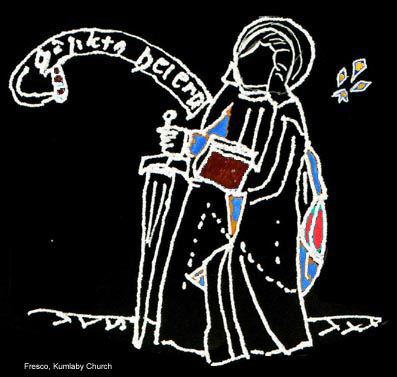
"Listen everybody:
Despise
the present, since it is ugly
to be fond of what steadily is under weigh to perish.
Love to the earthly things
must not imprison you.
Haughtiness must not bend you inwards.
Wealth must not blemish you.
Jealousy must not consume you.
Out of love for us,
our Redeemer lay dead for us..."
***31...THE COLLEGIATE CHURCH: Sister Jessica (O.Hel) states that S.Helena's Church in Skovde is the first one in the district, elder than eg. Womb's church. The parish of Skovde was a configuration of "the sokes of the seven villages and of the Elene; on its western side the two independant sokes of Hene and Womb were situated. On its southern side was maybe Kyrketorp, still without a church of its own". Skovde became an ecclesiastical unit, and there were the eccl. authorities. The Central Sanctuary of the tract was Helena's Church - it has been proposed that it functioned as a diocesan dome - in reality it was a collegiate church - and that it was founded as such in 1140! Its architect had apparently been inspired by Lichères' church - a sanctuary with a hostel along the pilgrim's route to San Diego di Compostella - applying his impressions, after his returning to Westgothia, on Helena's Church! The Skovde Administration followed LUND up to the year of 1300 - ( does that mean that Skovde District was annexed to Lund FULLY?). The Vatikan Consulate was situated in Skovde (acc. to a 18th cent. informer - but it is not true, alas).
Helena's body, so it was claimed, effected miracles (conf. Syr. 48:13-14), and business-men profitted splendidly on folks who kept streaming here to the latin Masses and the purgatorial easements. Her Church was one of the four highest ranking pilgrim's goals in Norden during the Middle Ages, whilst one only marginally succeeded in launching her cult on the Continent, viz.solely among the birgittines.
HELENA AS A MODEL: Even though Mrs Britta not once mentions Helena in her Revelational Books, we know that her aunt Katarina Bengtsdotter betwixt 1313 and 1316 lectured the Helenic Legend to her within the Mansion of Aspanaes: - it lay perched on a tall headland in the wild nature around Lake Sommen in Eastgothia - and Katarina's husband Kanutus Jonsson was an offspring of Helena Guthormsdtr in the 4th generation BOTH through Knud of Reval and through Ingeborg of Kalundborg (Kanutus was the actual regent of all Sweden for a while).
Helena's life served as a model to the Christians at that time - both for women and men. She was a strong woman: She directed her farm herself after having become a widow. She got along very well without a second earthly husband. Suffering couldn't lay waste her determinations. She regarded resistance as nix and nihil. To God she gave, not only her belongings, but also her corpse. Bishop Brynolf #1 writes: "What weakness can hereafter a man refer to as an apology, watching her, a woman, who despite being of the weaker sex, still conquered the world!"...
31.1:THE TOWN OF SKOVDE of today exists thanks to the richness that the very popular pilgrimages to the very attractive Helenic Monuments brought along. The protestants did all they could to stamp out our dear, beautiful spiritual Queen Saint HELENA, but they haven't yet succeeded! Her Shrine was most decidedly confiscated on the order of abraham angermannus in 1596, and her Holy Bones were probably dug into the ground near her Church. "Ab warred against the bones of the saints and their images and graves - he fought shadows in a ghastly manner" (expressed during the second last century).
31.2: WHERE IS HELENA's BODY TODAY? Through misunderstanding someone suggested that already in 1164 archbishop Stephanus transferred it over to Alvastra, but what he might have brought there was the helenic cult, which survived beyond Lake Wetter until at least the winter of 1314-15, along with a helenic Relique.
Some claim that Helena's Body was transferred in 1164 to Upsala Cathedral - the statement is of course completely crazy, but if it would have been true, it would mean that it was from Upsala that the Danes stole Helena's Body, bringing it to Tibirke. In the 15th cent. reliques of Helena did end up in Upsala Cathedral, though. And if her Body had been transferred to Upsala, it would have been destroyed as soon as Stephanus was exiled to Denmark (- aha! This might be how and when Helena's Body came to Denmark: Stephanus brought it with him thither; Wow!)
In Skovde one guarded warily the treasure, that Helena's body comprised, and one was afraid that the Danes wanted to steal it for to get at its beneficial, monetary function. Whenas the threatening stormclouds of the "reformation" commenced to loom at the horizon, this treasure maybe got transferred to Denmark nevertheless - to present-time Tisvilde-Tisvildeleje. Or, in 1596 maybe ab. angermannus saw to that it was interred somewhere in Skovde, and the same "he-man" saw to that the monuments of Brynolf too, in Scara, were destroyed.
31.3:Furthermore it has been proposed that Helena's treasured body was shipped from Karlskrona to the Vatikan/Rome in the 17th century (Karlskrona was founded in 1680; maybe the statement could be interpreted as "the place where Karlskrona was to be founded"). Anyroad, in 1734 every trace of beloved, enchanting, awe-inspiring Helena was gone from Skovde! But the story didn't end: From 1927 and onwards there was an old chest, containing the Church Silver, placed underneath the northern window of the choir of Her church here, at the basis of the ladder to the pulpit. By its side the great Grating was standing, and in the 1950:ies a pupil at school wrote in an essay that Helena's Reliques were preserved in that chest.
***32...Lauded be God that there are still a few reliques of Helena in this country. A chip of her fingerbone is preserved in a new-made silverbox in the altar of Gotene Church; another skeletal chip is embedded in charcoal in the altar of Wattlosa Church. In 1191 two different Helenic reliques were laid together with 93 others into the altar of Gumlosa Church/Scania (but these were all dug down in an unknown place in 1720). Yet another chip of her 'wonder-working finger' was re-found in 1938 in the altar of Molltorp Church* (lying beside reliques of Mrs Britta and of the Virgins of Ursula) and these have ever since been preserved in the County Museum of Scara...
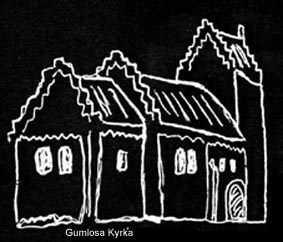
32.1: HELENIC RELIQUES: A)Gumlosa church. In 1191 her reliques were set into the altar. The church was subsequently inaugurated 26/10 1192, and it's the oldest exactly dated brick-built edifice in Norden. B)Gotene church. Her alleged ring-finger rests in a silver-box made in the 1960:ies. A helenic relique in the altar of Gotene was at least reported in 1944... C)Copenhagen. D)Roskilde (maybe from a relative of Sven Estridsen named Helena?).
E)Scara County Museum*. In 1938 the reliques from the altar of Molltorp Church were bestowed upon the museum. They're from Helena, Mrs Britta and Eleven Virgins of Cologne, and according to the lable and its 15th century text, Helena's reliques comprise a finger - since the bundle is very small, they must be interpreted as bony chips of her finger. The three silky bundles have one lable each, clearly reading from whom the reliques are taken. They are wrapped up in a thick leaden tain, hidden in the hollow interior of a miniature log. Drawing, 24/2205.
F)Skovde Museum owns a helenic reliquary, according to a journalist, 1996 12/12, at one-thirty p.m. inside Helénsgaarden, but he must have dreamed about one. G)A minor portion of Helena's reliques were preserved in Upsala Cathedral among its most costly hightlights. Helena is referred to as a VIRGIN of Westgothia - I guess not that they mean that she was born under the astrological influence of the constellation clept Virgin!
H)Wattlosa church: After a renovation of the church, the relique was replaced in the altar in 1910 together with a letter, and they were sealed in by cement. The relique is described as "A bone of a finger etc"!, and comes surely from Helena - it ain't taken from a pyre, as some say, just because it's embedded in charcoal. (And it has wrongfully been suggested that it's a part of the reliques from S.Lawrence, that Sven Estridsen got hold of in the Eastern of 1053, including "coal from the pyre". The name Lawrence happens to be chased into the foot of the chalice of Wattlosa church.)
32.2 - a *RELIQUE-special:
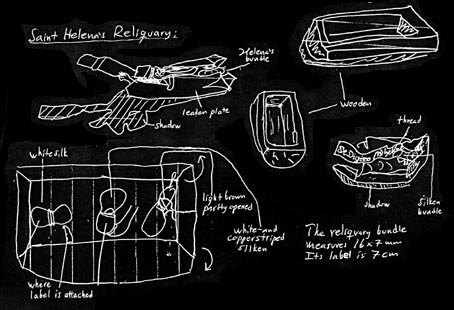
(An
account by Helena's Prophet, Uriël)
"Well, on the
International Women's Day 8/3 1994, about 2 p.m., I got the closest possible
to Helena's physical reliques - spiritually there are no limits - as I
by two employees at Scara County Museum, then not yet re-opened after
its transmogrification, was shown her reliques. I was permitted to hold
the cardboard box, in which the reliquary was preserved, in my hands for
a while".... "I made a very exact drawing of this reliquary 22/4 1997.
Its leaden bottom measures ~6 x ~2.5 cm, and Helena's white silky bundle
is ~16 x ~7 mm and her parchment lable-text is 'De Digito Ste Helene'
- i.e. 'From Saint Helena's Finger. The other two read: De Xj Mileb//s
Vgin//m; De Sta B'gitta".
(see p.511; this reliquary was displayed inside this museum 1995-97 as a part of a mishmash exhibition).
***33...Nine medieval pieces of Helenic art still exist, and there are several modern paintings, figurines and relievoes of her - and one cannot fail to find her Escutcheon - 'tis everywhere in Skovde!
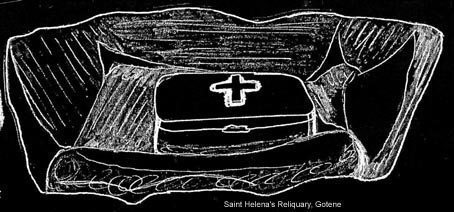
33.1: THE
HELENIC ART:
See also a Special
Helena's Art Gallery, 17/1267!
Also passim
in the Thick White Classeur;
also 8/317,
387, 457. 11/594, 655. 15/1131. 23/2012.
The oldest preserved picture of S.Helena is perhaps the one on her Seal of the year of 1314. It was made of wax, and was attached hanging under a parchment.
33.2: --WOODEN
FIGURINES IN RETABLES: --
(It is widely
taken for granted that the retables including Brynolf #1 cannot have been
produced until after 16/8 1492, when he was some kind of canonized, and
that those including Katarina of Vadstena not until after 2/8 1489, when
she was the same - acc. to Book of Saints Brynolf was really canonized
in 1498, and Katarina's cult was confirmed in 1484 - but this is not to
be taken for granted!)
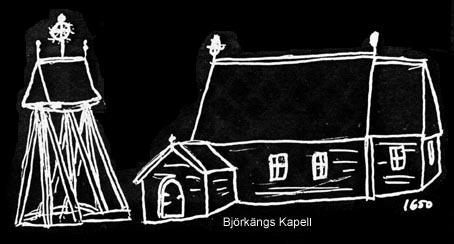
1. In TOREBODA brick-built church (inaugurated 2/10 1870): It was made around 1430?, and used to pose in the 13th century wooden chapel of BJORKANG, the true Birka as we helenists claim!, which was dismantled and reconstructed every 100 years for maintenance reasons, until it was finally dismantled in 1869 - parts of it were re-used in Toreboda church, built on the rock three stone's casts away. This figurine is different than all others: It's bigger and older and of another art-school. Please notice that the retable itself was made in 1738! Maybe the figurines too were made in 1738 (freshed up in 1928), replacing medieval but decayed predecessors; S.Antonia of Spain is standing underneath Helena. Bjorkang's chapel was maybe an original Helenic Temple - its awkward position proves that it was situated there for other reasons than to serve a farm or village - it's flooded yearly eg. - so its motivation was surely religious. The chapel has been entitled an "offering-church", but the offering of coins and other objects was made into a cavity, always full of water, on a big boulder existing close to the chapel. The memorial stone (of 8/12 1925) is standing some 25-30 yards from the exact spot of the ex-chapel. A full-scale copy of its belfry was built during the summer of 1992 on the double church-ruins of Karleby/ Mariestad. See special chapter on Bjorkang-Toreboda and p.896; 1002-03; 20/1551f. Drawing of this sculpture 000509 25/19, cf the one of 980701 e.g. 15/1131, 21/1693.

2.In GRASMARK church: Traditions claim that this retable was brought over to Wermland, then a part of Scara Diocese, by immigrants from Finland. Twice as sure is the statement that it was first mounted in Sunne Church (certainly not in East Emtervik), and fully surely it was mounted in the older Grasmark Church at some distance from the new building. This Helena was made in around 1500, and its lovely, painted original is nowadays preserved by SHM (Statens Historiska Museum) in Stockholm. But in 1981 a bulgarian carver, Jordan B. Jordanov, made a tip-top copy of the retable, which is hanging inside the new Grasmark Church. Brynolf is one of the three other saints of it.
--.In GOTENE Church: Alas this figurine is an Amazing Disgrace! A MALE, paintless, armless idol from the un-renovated retable was furnished, in the 1960:ies, with new arms and baptized 'Helena'. Some centuries back the Madonna was wrongfully thought to be Helena; as things are today, Her own churches in Gotene and Skovde LACK a medieval representation of her in art! (It has befallen Helena's namesake, the mother of Constantine, too, that one of her sculptures are shammed: In the crypt of the Holy Cross Church that she built in 320 at Rome, a Juno-sculpture was given new arms and a new head and was furnished with a cross, in order to become a Helena-sculpture!)

3.In KULLINGS-SKOVDE Church: This Helena, made in around 1500, is since 1878 preserved in Gothenburg by a museum; presently it is standing in a museum storehouse on Hisingen Island. A gypsum-copy is shown in Skovde Museum. The original figurine is in a miserable condition. (A full description of this retable, see p.848; 1303-04)
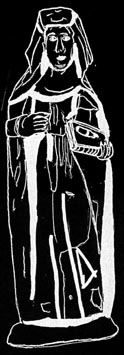
4.In RUDSKOGA Church: This Helena was made in around 1500. (The old church lay near by the present one, built in 1777.)
5.In VISNUM Church: This Helena was made in around 1500; she's the most beautiful one. (Wisnhem first mentioned in 1248; the present church was inaugurated in 1733).
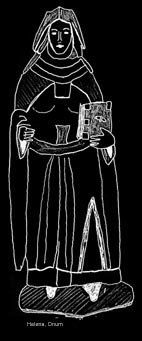
6.In ONUM Church: This is the fifth of the Helenas that's made probably in around 1500 by the same carver. An artstudent has discovered that Onum's Helena perhaps firstly belonged to the retable of Vara church - the Vara retable is in SHM now - since the Helena has left its outlines in it, which are perceptible thanks to shifts of the paint. Anyroad, Onum's Church is today a true, sacred helenic church. (This retable was displayed in the Old Library of Scara during the spring of 1994). Its Helena has held a staff and not a sword in her right hand. The original site of the church and its cemetery by Stommen, where a 17th century building had replaced the medieval one, was abandoned in 1865. A full description of this retable see p.1006; 1073-74.
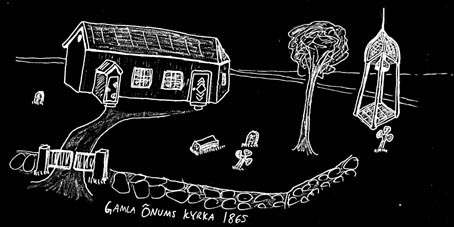
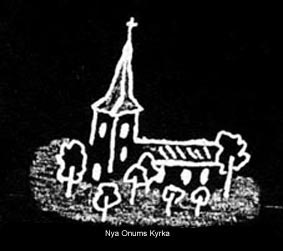
33.3: --Uncertain
figurines--
From either
North or South HARENE a wooden Helena has been transported to the "Westgothian
Museum in Scara". There they deny it, and there are at least 3 large other
museums in the region in which this figurine might have been displaced.
In 1872 a mormon Elder took a carved image of Helena from her Well in Tibirke / Denmark with him to Utah/ USA. See the Year List below!
In Varola a Helena figurine was kept in the house of a wellknown churchbuilder, but it's unknown where he'd gotten it from. Unfortunately it's equally unknown where Skovde Museum has displaced it...
West Skedvi, 15 km northwest of Arboga, maybe owned a wooden Helena in its retable, which Ab. Angermannus and his "superheroes" in 1596 "sent off to happier hunting-grounds", as it were.
33.4:MURAL PAINTINGS ON CALX:

KUMLABY Church on Visingso/ Jonkoping Commune - this island is situated south of the spot where the counties of Westgothia, Eastgothia and Smaland meet among the waves of Lake Wetter. Kumlaby is interesting since this painting was the very first image of Helena to be rediscoverd (apart from her Seals), in 1922 to wit. It was painted in the 15th century using her pilgrim's Badge to go by. The painter used the same method in painting Mrs Britta, next to Helena. Their names are painted on banners under the "New Jerusalem", descending from above. The building is profaned, and has been used as a school e.g.
(In 1996 a 3 x 7 yards wide mural painting was made on concrete in the assembly hall of Swedish Ecclesiastical House at Skovde. The two painters have combined the reminiscence of Elene of Mykenae and that of our Saint Helena, bravely enough, and the Lion's Gate of Amyklai is depicted and an alleged greek landscape, along with a depiction of the choir-end of St. Helena Church of Skovde and four and a half painting of their own Helena-symbol-relievoes, see below, viz. the Chalice, the Sword, the Heart and the Hour-glass).
33.5: --UNCERTAIN ONES--
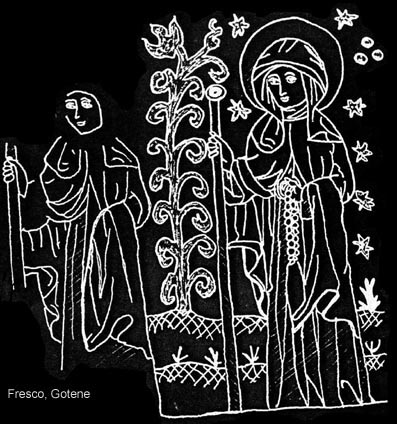
One guesses that Helena is the left woman painted on the southern side inside the arch between the nave and the choir of GOTENE Church. The two others are, by guess, Mrs Britta and her daughter Katarina of Wadstena, but the paintings have been retouched in order to create conformation, and this was done BEFORE Helena had been rediscovered - the workers didn't know who she was. And eg. Katarina has been furnished with the birgittine attributes (and on her head there's a military helmet with a camouflage-net on), and Helena has been furnished with a rosary in her left hand - that hand was originally hidden under the garments. Maybe these three woman simply are pilgrims coming to worship Helena in Gotene! Or else they might be Etheldreda and two of her saint-sisters, which would rhyme very well with this anglo-saxon church!
33.6: --OIL-COLOUR PAINTINGS--

On the inner side of the right shutter of the retable in NORTH NY Church, there is the by far most famous image of Helena. The five knobs on the cover of her book represent the spikes hammered into the Cross of Jesus Christ. There are many oil-colour copies of it, whereof one now is standing in the tower-chamber in Helena's church/Skovde, and this painting served as a model to the artist when she made her cupreous Helena Statue, see below. Before 1764 the church (N.Ny) was situated 2 km to the south, along the River.
Helena actually used to be depicted within frames on the preacher's pulpet in Her church in Skovde, but the same is packed up in boxes and placed in a place unknown.
Inside a villa at Tisvilde there are 14 oilcolour paintings presenting the local midsummer activities and the legend of Sankt Helene. The painter was Ove Kunert (1893-1975) and they were painted ~1916-20. Helena looks like a light-emitting Angel.
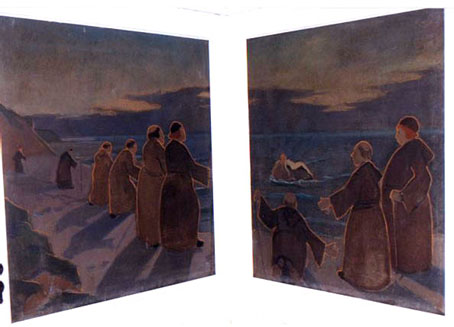
Ove Kunert, Sagnet om Tisvilde
33.7: --UNCERTAIN ARTICLES--
Someone is writing that she can see "Elin" depicted on the right lower corner of the retable in HEDARED Wooden chapel, hooded, holding a long staff or a sword pointing up above her right shoulder - it's nonsense. To begin with, this is a MAN, and then it's obvious that the twelve guys around the retable are the 12 Apostles - and so the guide there says.
33.8: --A DRAWING:--
A militarist of Skovde, G.H. Barfod, made a drawing in 1767 of S.Helena. She holds a staff in her right hand, whilst the left hand is hidden by the garment. She wears a hood; is dressed like a peasant wife. Beneath her feet there's an escutcheon decorated by a heart.
Jörgen Sonne made a drawing in 1846 of 'Midsummer Night upon Helena's Grave' at Tisvilde.
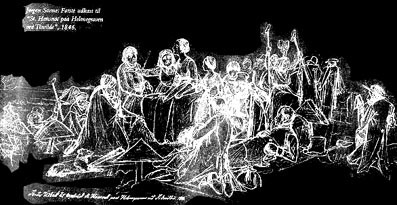
Jørgen Sonne, First Sketch to Midsummer Night on Helene Grave at Tisvilde, 1845
33.9:In NOUSIAINEN Church, some miles north of Aabo/Finland, Helena is one of the saints ENGRAVED on the brass-plates of Henrik's cenotaph, made in 1430 in Flandern.
33.10: COLOURED GLASS ART:
1888-1927 Helena was one of the four 1½ yards tall saints represented in stained-glass art on the choir fenestrastion behind the altar in Her church/Skovde. They all got haloes. Probably this Helena looks like her Escutcheon-picture? After the leaden joints had begun to give in, the fenestration was packed into boxes and placed - no-one knows where. In 1927 there was another stained-glass art in place of the older one, and maybe it was retained until 1972. It described 7 scenes from the Bible under the All-Seeing Eye of God.
In 1956 a stained-glass Helena was made for SCARA's Cathedral: It's a stylish piece of art. She's holding a BLUE sword with her left hand and a black book, on which a silvercoloured finger rests, with her right hand.

Bo Beskow, Sankt Helene, Skara
33.11:DISAPPEARED
HELENIC ART:
There must have
existed Helenas in A)Her church in Skovde before mid-16th century. B)Her
Oratory outside Skovde. C)the Cathedral of Scara.
33.12:
WRONGFULLY CLASSED HELENAS:
A)As we've already
told, Helena is utterly female and attractive, and thus folks turn trigger-happy
in finding images of her in their searching for such. In 1920 and 1929
the painting of a male man by Amund (15th cent.) in the ceiling of the
choir of Gotene Church, was clept Helena!
B)Wrongful is also the pseudo-helenic identification re a painted crowned woman on the southern wall in the choir in Gotene Church. A book is tucked up under her right arm, and she holds forth an empty left hand. She ain't Helena, though a crown could have been expected on her head, respecting her mother's angelic premonstrating.
C)In Skee in Bohuslan (ex-Norway) the woman with a cross and a church in the retable "that conceals the apse-fenestration" is NOT Helena, irregardless what you can read in a brand-new book on modern pilgrimages in Sweden. D)Tortuna church - it's Lucy, not Helena. E)East Emtervik - should be Sunne Church. F)A caboodle of medieval artists' representations of St. Helena exist "naturally" in Upland County according to a span-new pamphlet treating Helena's church at Skovde - "maltreating" is a better word, because the pamphlet is void of true information. Except for the Grasmark retable kept by SHM there are no pictures of our westgothian Helena in Upland.
G)Overselo Church: Here you can count to Five Male Men carrying a Book and a Sword! Let me hereby excommunicate the rumour of a helenic image in this here church and include the other six wrongs - and the conservers of these lies too: DO THE BOOK TO; BLOW THE CANDLE OUT; SHUT THE DOOR TO and RING THE BELL - AMEN!
33.13:THREE
LOOSE DELINEATIONS:
"The oldest
images of Helena show her holding a STAFF, standing inside a MONSTRANCE,
looking like an ABBESS. Other representations show her with a veil, sword
and a book on top of which there's a ring-finger, so the copy from 1591
of a Helena Seal is unique. The cloisteral attire and the staff are not
connected to her in church-art. As recently as in the late 18th century
though, she was painted as a nun high above the ground on the outer southside
of her churchtower/ Skovde. S.Norbert too, the founder of O.Praem, is
represented beside a Monstrance, and thus it's understandable to find
Helena represented in the same way - she took the O.Praem veil in Jerusalem
in 1138. There is always a S.Helena's Well near all Scandinavian O.Praem.
Houses. And O.Praem.canons owned estates around Skovde City and, e.g.,
between Hojea and Fjelie..."(CM Brahm, 1796).
" A BOOK with a finger was decided in 1939, 12/1, to be incorporated into her & Skovde's escutcheon. The STAFF was surely her pilgrim's staff - 'tis otherwise an attribute of an abbess. Originally it could have been a twig of a palmtree or a writing-feather-pen? She's WEARING the attire of a cloisteral order, covered by a mantle; has the golden crown of a martyr on her head; holds a golden chain. .." (van der Schatten, 1968)
"In Helena's Church in Skovde there was a stained-glass image of her in the choir 1888-1927, but it is mentioned among the other pieces of art existing in the church in the 1950:ies, along with one painting on the preacher's pulpet and two on the choir walls - one of them is still there, surrealistly accomplished, showing Her flanked by the churches of Skovde and Womb. Preserved is also Her 15th century grating, mounted underneath this last mentioned picture. On the outside the cupreous helenic statue is standing since 1950 in a niche, gazing near-sightedly down along Hertig Johan's Street unto Resecentrum (Railroad Station), with a sword in her right hand pointing upwards, and a Bible in her left hand. On the same side of the church there are the 13th century bears or lions, mounted there in 1888 - on top of the jambs these beasts hold tight one man (Gustave Wasa?) and one goat (Martin Luther?). In the Park there is the large one-piece-pillar of stone called Gyllen with relievoes, on top of which an austere virago is sitting, and under her water is flushing to the four cardinal points - on the south side "S.Elin" is shown infront of Womb's Church, onto Wombo Rivulet. Skovde Museum owns eg. Her Stony Loaves, the important Ink-Drawing from the 1750:ies of Her Oratory-ruin; copies of the Vatikan notes on Helena - but the actual documents of the 1160:ies have been destroyed by Fire; models of Skovde Town of the 18th century, the Oratory, Her Church; a well-model with Living Water, etc. (Muriel X-fyle, 1994)
33.14:The HELENIC CITY-SEAL was mentioned in 1467, and its oldest preserved one is from 1591 ("Sancta Elena Sigillum Ville Skedvensis"). And Helena looks like a bandit holding a bludgeon on a seal-like image which is significantly used by the church in Skovde nowadays - and their folded paper of polyglot information of this church shows a drawing of their Taube statue. An helenic escutcheon was drawn in 1767 by G.H. Barfod, and a Seal of the helenic trade-union was preserved by pastor Nikolaus Rabenius (1648-1717). The anteceding helenic City-Seal was approved of in 1939, and 5/8-1992 it was authorized that this escutcheon ("logotype") must be used on all communal letters and envelopes, advertisements and documents, until it was replaced in the New Year's Evening of 2000, see the following Part Four. (20/2-2001 corresponds to "5/8-1992" as regards the present City-Seal, but this description concerns the antecessor):
--On top there are five turrets. Centrally Helena's posing inside a monstrance. She's holding a pilgrim's staff in her right hand and a book with a finger on in her left hand. She's got a halo, and infront of her feet there's an INESCUTCHEON showing a heart - originally this latter arrangement was a knoll, which grass happened to be slightly heartshaped, and it has been idealized. (This green knoll, on top of which she oftentimes is represented standing on in retables etc - ain't it Elinmarks's Knoll, on which Westerhojdsgymnasiet poses today?). The colours of this 1939-version are gold, white and red mainly, and this strict helenic picture decorates Roadsigns, Gonfalons, Vehicles, Litter Receptacles etc in Skovde Commune.
33.15:MISCELLANEOUS
HELENIC ITEMS
(others than
already mentioned)
A)An ALTAR was dedicated to a widow of Westgothia yclept Helena in 1440, 20/11, and 'twas placed centrally inside the Cathedral of Upsala.
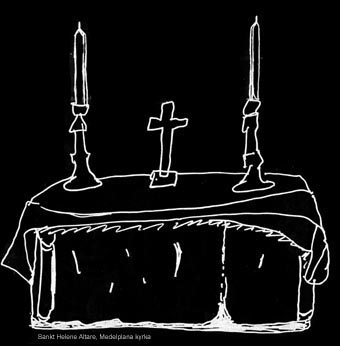
Since 1971 there's a Helenic ALTAR in Medelplana Church, measuring: height 58 cm; length 135 cm; max.breadth 105 cm; breadth of flat top 60 cm; Two half-sunk corner-columns measure 45 x 12.3 cm. See 22/1877. The sister-altar of S.Apollonia of the same church measures: height 45 cm; length 135 cm; max.breadth 83 cm. Two corners have shallow double niches. See 24/2233.
In Wettlosa Church its 11th century stone ALTAR was hidden inside a wooden covering between 1910 and last renovation. Thereafter an inorganic material shuts up the original stony core - and that's where the Helenic relique still is preserved. It is likely that Helena knelt before this altar on celebrating the Lord's Supper. She was surely baptized in the FONT here, see special chapter on Wettlosa - it was shipped in 1872 from Lidkoping, via the Canal, up to SHM in Stockholm.
B)The municipal ESCUTCHEON of Gotene was approaved of in 1953, on which there are represented a cross above S.Helena's Well, flanked by a sword on each side. In Gotene Museum the Helenic legend is illustrated by way of CARTOONS, influenced too by the North Ny oil-painting.
C)Examples of Helenic Cult-sites: ALVASTRA (where Her cult hibernated), GOTENE (two wonders), KALLEGAARDEN (wonders), LYNGSJO (pilgrimages to her well and oratory), SKOVDE (3 wonders at Her Grave, 2 on the cemetery, 1 adjacent to the church) TIBIRKE (countless wonders). LAKE WETTER north of Visingso (where Helena repossessed bishop Brynolf #1 13/8 1288).
D)Helena's Stone off Tibirke, on which, during ebb-tide, one can still see the impressions of her body.
E)The Kildeblok at Tisvilde - the coins offered with reverence towards Sankt Helene were inserted into its metal dorsal slit. This cubic and holy thing is protected by a small building.
F)The "fathomless little lake in Klyftamon of ELINASJON" in Holmestad parish - no-one knows today where this is.
G)ELINEGERDET/ Horred parish, first mentioned in 1540, might indicate a local, Helenic position - the farm is now called Alegarde; {halvt mantal frelsegard}. (The buss-stop sign reads Elinegaerdet; it is situated by a rivulet meandering to Greater Horred Lake nearby; two small farms are seen from the road).
H)There are/were 3 CLOVEN STONES connected to Her cult: 1.in Mone parish near her well - {read: the well of Eliah. It was connected to Helena in the 1950:ies thanks to wellmeant guesses}. 2.within reach from Her church in Skovde - gone before the 1250:ies despite all stories afloat. 3.On Her Grave in Tisvildeleje - {a misunderstanding: The standing stones constitute a part of the wall of the ruined helenic oratory there}; but maybe the metalclad Kildeblok contains a cloven, or otherwise remarkable, stone.
I)At the herby garden outside Helénsgaarden/Skovde a bricklike ceramic picture is hanging, maybe featuring Helena holding a staff, on a knoll, above a heart, made by the founder (1912-87) of this park.
J)Three ZIP-CODES bearing Her name exist in Sweden: Helenavagen 763 41 HALLSTAVIK, Sankta Helenagatan, 541 30 SKOVDE. Sankta Helenas Vag, 271 32 YSTAD. In Tisvildeleje there are Sankt Helene Vej, Helenevangen and Helene Kildevej.
K)"Helene Kirkes Laen", the County of the Church of Helena did exist at LUND, confused with the County of the Holy Spirit in the same town.
L)An alleged Helenic pilgrim's badge is soldered on to the churchbell from 1498 of FREDSBERG's Church, next to badges of Olav and Mrs Brita.
M)In 1996, ten relievoes on slabs of calciumrock were produced and mounted in the assembly hall of Swedish Ecclesiastical House at Skovde. They present 1)Saint Elin's Well. 2)A ripped Mitre. 3)"The Thorn and the Eye". 4)The Heart. 5)The Chalice. 6)The Ring. 7)A broken Crucifix. 8)Eight drops of Blood and the Grating. 9)The Hour-glass. 10)The Sword, partly golden. (Numbers 1, 6, 8 and 10 make sense, since they are motivated by Helena's Legend; the rest seem to be remote: The Mitre (2) of Helena was invented by O.Hel in 1998; otherwise it must be a Brynolphian symbol. The Thorn (3) is a true Brynolphian symbol, while the Eye could be a reminder of that Helena has healed blind eyes. The Heart (4) looks like four ginger-biscuits and possesses maybe a likeness of the communal escutcheon of Ysby-Ranneslov. The Chalice (5) has too remote a motivation to be understood, along with the broken Crucifix (7). The Time-glass (9) was invented in 1998 by O.Hel: Helena preserves her eternal youth by turning it around whensoever it pleases her.
End
of Part Three
Go to
Part Four
Superhelena
Illustrated version:
Superhelena1
Superhelena
2 Superhelena
3 Superhelena
4
Appendix to part
4: Helena Dialoque
Contents
English
version
Non-illustrated
version: Superhelena
1 Superhelena
2 Superhelena
3 Epitome
Brynolf
Algotsson
about Helena, 1288
Innhåll
Superhelena svensk version
Superhelena
1 Superhelena
2 Superhelena
3
Brynolf
Algotsson om Helena, 1288 Sankt
Appollonia
Översättning af Joseph Dunney: Saint
Of The Snows
Albany, New York 1937 Snöfallens Helgon:
Förord
Dokument 1
Dokument
2 Dokument 3
Efterord